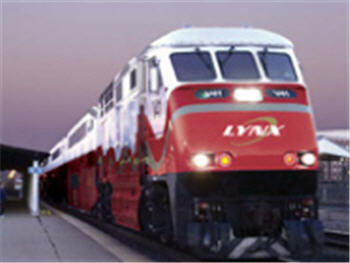Charlotte-to-Mooresville Train Being Considered

Tuesday, November 22, 2011
Various city and county leaders have been pushing for over a year to approve plans to extend Charlotte’s proposed Red Line commuter train into the city of Mooresville.
Leaders said the Red Line will not only move people across the region, but also will serve as an economic engine for Lake Norman.
“A great benefit of the rail lines will be development,” said Carroll Gray, executive director for the Lake Norman Transportation Commission. “It’s the tax base and job development that really makes it a true investment rather than an expenditure.”
Officials believe the return on investment will well exceed the cost for 10 stations spanning from Charlotte to Mooresville, just south of Lowe’s corporate campus.
Iredell county leaders have been skeptical thus far about the Mooresville-to-Charlotte train. Without the support of Iredell County, the Red Line commuter and freight rail is likely to die, representatives from the Red Line Task force told leaders during Monday’s specially called Iredell County Board of Commissioners meeting.
The business and financial plan for the rail will be unveiled at 5:30 p.m. Nov. 30 at Charlotte Government Center. Members of the task force presented an outline of the plan Monday.
The rail, which would run 25 miles from Gateway Station in downtown Charlotte to the Lowe’s corporate headquarters in Mooresville and include 10 stations, would cost an estimated $452 million to build. A possible future extension to Statesville is not included in the price tag.
The plan calls for collaboration between the N.C. Department of Transportation (NCDOT), the Charlotte Area Transit System (CATS), Mooresville, Charlotte, Huntersville, Davidson and Cornelius, as well as Mecklenburg and Iredell counties.
The plan calls for NCDOT and CATS to each pay for 25 percent of the project, with the remaining seven jurisdictions taking on the remaining 50 percent. The state is the credit backstop should funding fail.
“If you don’t have everyone, you have nothing,” Paul Morris, NCDOT deputy secretary, said.
The plan advises the jurisdictions to raise their half of the money through local value capture funding. Two types of funding would be especially used, said Morris: tax increment financing and special assessment districts.
Morris said the value of real estate that surrounds the rail line would increase as the project begins. Tax increment financing uses estimated future gains in taxes to finance projects. The difference between the current property values and the projected values after construction is determined and a portion of that would help fund the line. Morris said no residents would see a tax hike if the plan comes to fruition.
Special assessment district financing comes from when income-producing property owners (commercial properties) who live within a certain distance of the rail vote to self-impose a fee or tax based on their property’s value. It requires that more than 50 percent of the property owners of those income-producing properties vote yes. Morris said the districts usually include commercial property owners living within a half-mile from the rail. These fees do not apply to residents — only commercial property owners.
Other types of financing in the plan are joint development and negotiated exactions, where private businesses or developments that would be along the line contribute because their property and business values would rise with the advent of the line.
“Infrastructure investment triggers value increases,” Morris said.
Board Chairman Steve Johnson and Commissioner Renee Griffith were skeptical of the ways suggested to raise money.
“In my 17 years, I’ve never seen so many taxed so heavily to benefit a few,” Johnson said.
Estimates for the rail are 4,000 to 5,000 riders a day, or half that number making round-trips.
Commissioner Ken Robertson said that Iredell County needed new businesses, not new developments and residential areas for people living in the county, but working in Charlotte.
“One of our worst nightmares is to become a bedroom town for Charlotte,” Robertson said. “If we make it easier to live in Mooresville and Iredell County and work in Charlotte, we will have a gigantic burden to build a lot of schools really quickly.”
After the business plan is outlined Nov. 30 in Charlotte, the plan will be laid out more in-depth for all elected officials Dec. 13 in Mooresville. The plan will be reviewed by all jurisdictions during the first six months of 2012. If all parties approve, the plan is activated and construction will begin in 2014, with the rail operational by 2017, at the earliest.
The rail plan accommodates both commuters and freight. Morris said the line was critical for connecting both nationwide and globally in the freight business.
Project Manager Brian Nadolny said that the number of people employed in the areas the rail will serve is going to double by 2030. He said 10,000 residential units are planned for the North Corridor jurisdictions.
Nadolny said I-77 traffic was expected to double in the next 30 years and an expansion of the interstate would cost $400 to $600 million.
Red Line Project Overview Website
Please Like CH’s New Facebook Page! New Giveaways Coming Soon! www.facebook.com/charlottehappeningcom
Follow CH on Twitter! www.twitter.com/charlottehappen




